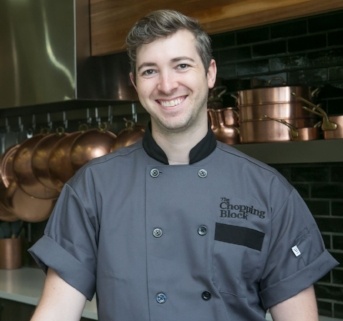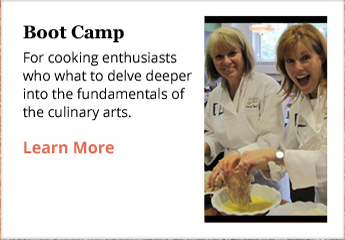Cooking eggs is one of those things that professional cooks tend to obsess over. Even the number of pleats in a traditional French toque (100) supposedly represent the 100 different ways to cook an egg. Of course, there are far more than 100 ways to cook an egg, but the point stands that eggs occupy an outsized place in the hearts and minds of many of the best cooks and chefs in the world.
 But I have never quite understood this fascination. I do like eggs quite a lot, though not as much as other folks seem to (get your fried egg away from my cheeseburger, thank you). It seems many people would be happy to add an egg to just about any dish and call it an improvement. I believe they have their time and place, and I don’t love all preparations equally. If I'm eating just straight up cooked eggs, with little to no adornment I tend to prefer scrambled eggs. Of course, this does little to narrow the field of potential preparations. There are almost as many ways to prepare scrambled eggs as there are cooks that make them. Do you make your scrambled eggs runny or stiff? Dry or juicy? Curds small or large? Completely homogenized, or with bits of white still visible? There are so many variables you could easily make scrambled eggs of a different style every day for a year, perhaps longer.
But I have never quite understood this fascination. I do like eggs quite a lot, though not as much as other folks seem to (get your fried egg away from my cheeseburger, thank you). It seems many people would be happy to add an egg to just about any dish and call it an improvement. I believe they have their time and place, and I don’t love all preparations equally. If I'm eating just straight up cooked eggs, with little to no adornment I tend to prefer scrambled eggs. Of course, this does little to narrow the field of potential preparations. There are almost as many ways to prepare scrambled eggs as there are cooks that make them. Do you make your scrambled eggs runny or stiff? Dry or juicy? Curds small or large? Completely homogenized, or with bits of white still visible? There are so many variables you could easily make scrambled eggs of a different style every day for a year, perhaps longer.
So to be clear: I prefer smooth, fully mixed scrambled eggs with light, fluffy, moist, large curds. I don’t care much for the French style made famous by Gordon Ramsey that has very small curds, a nearly equal proportion of butter to egg, and an almost pourable consistency. Neither do I prefer hard scrambled eggs that are lightly browned and end up either with an almost crispy outside and foamy inside, or weeping clear liquid onto the plate.
Most of the criteria I’ve laid out above are relatively easy to achieve. Just don’t overcook the eggs and light, fluffy, and moist should be no problem. But the rest of it–smooth and fully mixed, and very large curds–can be surprisingly elusive. So let's take a look at them individually real quick.
First, let's look at homogenization. Up until very recently (like yesterday) I would just mix my scrambled eggs with a fork. This gets the job done well enough. However we’re not here for well enough; we're here for dialed in am I right? To this end, I actually think the best way to mix your scrambled eggs is by hitting it with an immersion blender.
 This might seem insane, but I promise it's actually faster than just beating the eggs with a fork (even including cleaning the immersion blender), and the result is a million times better. It also helps to incorporate the secret ingredient that helps with the second criterion.
This might seem insane, but I promise it's actually faster than just beating the eggs with a fork (even including cleaning the immersion blender), and the result is a million times better. It also helps to incorporate the secret ingredient that helps with the second criterion.
Curd size. Eggs can be so delicate when cooking that even just using a spatula to gently lift them from the bottom of the pan can (and almost always does) cause the curd to break. This limits our maximum curd size to what I would call acceptable, but not ideal. I want my curds to be almost sheet-like in their scope. One way we could achieve this is to leave out the dairy in our mixture. This would grant added strength to the curd, but at the cost of fluffiness and – most importantly – softness. A scrambled egg that's all egg and not lightened with any extra moisture can have an unpleasant rubberness to it. In order to maintain light yet resilient curds, all we need to do is add a little bit of cornstarch.
 The only ingredients you need for great scrambled eggs: eggs (I'm using three small eggs here), some salt (about ½ teaspoon), some milk (about 1 tablespoon), and some cornstarch (about ½ teaspoon)
The only ingredients you need for great scrambled eggs: eggs (I'm using three small eggs here), some salt (about ½ teaspoon), some milk (about 1 tablespoon), and some cornstarch (about ½ teaspoon)
Yes, that's right cornstarch. This is not as out of left field as it may seem. It is a common addition to egg mixtures in Asian, especially Chinese cooking, and for largely the same reason as we’re using it here. Moisture retention, and curd strength. It's actually giving us a double benefit here as it helps to give the curd extra strength and flexibility while also helping to keep the eggs retain moisture and prevent weeping. Take a look at the images below to see it in action.
 Egg mixture and butter in a pan over medium heat
Egg mixture and butter in a pan over medium heat
 Let the eggs cook without stirring until you see the edges begin to set
Let the eggs cook without stirring until you see the edges begin to set
 Now use a rubber spatula to swipe the curds away from the bottom of the pan, allowing still liquid egg to run onto the bottom of the pan to start cooking.
Now use a rubber spatula to swipe the curds away from the bottom of the pan, allowing still liquid egg to run onto the bottom of the pan to start cooking.



 Give them a little flip to set any uncooked egg that might be on top if you wish.
Give them a little flip to set any uncooked egg that might be on top if you wish.
 Plate up and enjoy
Plate up and enjoy
 Or maybe use them to top some lovely sautéed asparagus
Or maybe use them to top some lovely sautéed asparagus
As you can see, the eggs cook as a basically unbroken single curd giving a fantastic texture, and if you look at the first image in the post, you can see that the eggs are both fluffy, and moist with no weeping despite exposure to relatively intense heat. If you like this style of scrambled egg as much as I do (a lot) then I really encourage you to give this a try. And If you want to improve your all-around egg cooking skills even more, I highly recommend checking out our Culinary Boot Camp.











